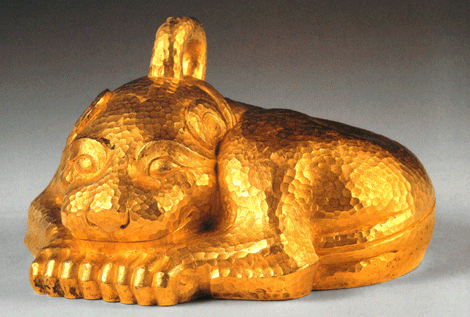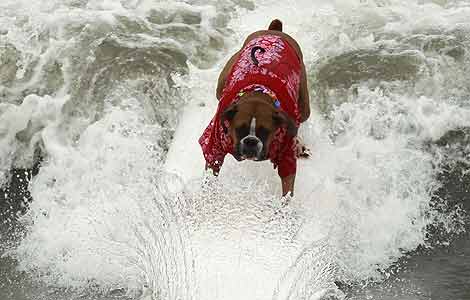Treasure trove
Updated: 2011-10-09 08:01
By Zhang Kun (China Daily)
|
|||||||||
|
At almost one kilogram in weight, the beast was the largest gold item among archaeological finds in China to date. [Provided to China Daily] |
While others were enjoying their Spring Festival, a farmer toiled in his fields. His diligence was rewarded with an amazing find. Zhang Kun continues the story.
On the seventh day of the Lunar New Year, a farmer decided to go back and work his fields after the Spring break while his other villagers were still in holiday mood. This was in 1982, in the village of Mahudian in Xuyu County, Jiangsu province.
Wan Yiquan was digging out an aqueduct when his shovel hit something hard and glittering. He jumped into the ditch and worked with his hands to remove the earth and uncovered a golden beast that resembled either a tiger or a panther. It was 10 centimeters high and 18 centimeters broad.
At almost one kilogram in weight, it was the largest gold item among the archaeological finds in China yet uncovered.
 |
The tiger-panther beast has a large head and long tail, and is curled up with its head resting on its front paws. It wears a collar and has a knob on its head. Round patterns all over its body were created by repeated hammering - the work is an ancient technique that combined highly purified molding and gold beating. It is not often seen these days, and that makes the piece even more precious.
Under the gold animal, farmer Wan also dug out an elaborately worked bronze pot, and within the pot were lumps and nuggets of gold weighing more than 20 kilograms altogether.
"According to Chinese law, antique treasures unearthed belong to the state," says Yang Haitao, a deputy director of Nanjing Museum.
Wan was given a reward of 10,000 yuan ($1,564) for his contribution. In the early 80s, that sum equaled the spending power of about 1 million yuan today, says Yang.
The farmer spent his reward renovating his house, which had suffered damage when the villagers broke into his house trying to get the gold. He also bought a tractor.
The golden beast and the nuggets in the bronze pot were highly purified gold, and showed how sophisticated metal processing techniques were in ancient China.
In 2007 the gold animal was named the most treasured exhibit in Nanjing Museum.
 |
The bronze pot from Wan's aqueduct was no less significant. It featured complicated molding technique and scientists and archaeologists were fascinated.
"It was an alloy of several different metals, combining several different melting points," Yang explains. "Normally, if you mold the interior first, it will melt when you mold the surface layer of metal. But if you mold the surface metal first, it would be difficult to work the interior."
If scientists can successfully recreate the molding process, it will be an important breakthrough in metal processing.
Experts decided that the gold animal and the bronze jar were probably buried during the West Han Dynasty (206 BC-AD 24).
What was the gold animal and what was its use? Some archaeologists say it was a weight used by the emperor to weigh down his mat.
"No other animals like this have been found though, so the animal was probably largess from the emperor. Perhaps the owner, maybe a privileged official of high rank, had broke the law and his possessions were about to be confiscated when the family decided to bury the most valuable items."
Based on these assumptions, some archaeologists have guessed that the treasure's owner could have been Han Xin (231-196 BC). A martial who had helped Liu Bang establish the Han Dynasty, he was later executed after being accused of inciting rebellion.
You can contact the writer at zhangkun@chinadaily.com.cn.












